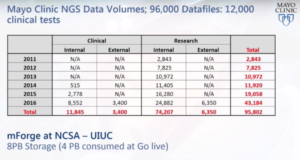
Medicine’s Data Transformation, From Genomics to Reforms

(Wichy/Shutterstock)
The interaction of big data and healthcare is transforming medicine, but clinicians and regulators continue to struggle to achieve the ultimate goal of making data serve patients through “evidence-based care.”
Those were among key themes of a healthcare data conference in Washington called the Healthcare Datapolooza, an annual gathering of healthcare providers, startups, government regulators and data geeks. Given the upheaval within the healthcare sector, including attempts to repeal the Affordable Care Act, or Obamacare, healthcare economists at the conference also stressed the possibility of “data-driven health reform.”
Experts also noted the impact of data and analytics on medicine, especially in areas such as genomics, where according to one estimate the cost of sequencing a genome that at the turn of this century cost $100 million has declined to under $1,000 per genome. The “explosion in genomics” is “unleashing a huge amount of power in the data that we have buried within ourselves,” Amy Compton-Phillips, chief clinical officer at Providence St. Joseph Health and Services, told the conference.
These and other byproducts of medical big data are promoting “the use of evidence in decision making,” added Lisa Simpson, CEO of conference sponsor AcademyHealth. Among the outcomes, proponents said, are using data to promote “precision medicine.”
Compton-Phillips and others noted the confluence of data and healthcare IT over the last decade, most notably the rise of analytics frameworks. Along with the emergence of social networks, smartphones and data sharing, Hadoop was released, “so we could have massive parallel processing and the advent of big data,” she noted.
Indeed, some industry estimates forecast that greater use of big data could result in healthcare cost savings approaching $450 million. Using tools like Hadoop to gain access to unstructured medical data that is growing exponentially is seen as one way to increase efficiency and cut costs while improving patient care.
“Those changes that happened [a decade ago] are starting to seep into [healthcare] and we have that same kind of rapid shift accelerating what we’re doing today,” Compton-Phillips asserted. “Now is a momentous time of huge possibility in healthcare for us to think differently and act differently.”
Meanwhile, doctors and clinicians are leveraging big data tools to gather, analyze and learn from data and “really start to understanding what truly makes us sick and what makes us well,” she added.
Much of he discussion at the health data event focused on redirecting the fruits of data analysis toward consumers. “It’s all about patients. It not about the data, the machine learning, the apps,” stressed Niall Brennan, chair of the Healthcare Datapolooza and former chief data officer at the Centers for Medicare and Medicaid Services.
“Those are just tools and techniques. They are a means to the end. The end is leveraging data into the information and insights we need to transform care delivery, lower costs, improve quality and get doctors and patents and all the other players in the healthcare system the information they need to make the system work better,” Brennan added.
Tom Price, the new secretary of the U.S. Department of Health and Human Services, told the conference one regulatory goal is “how to make life better for American patients through better data and better use of health IT.”
Price, a physician and long-time critic of the Affordable Care Act as a member of Congress, emphasized the “frustration” within the healthcare sector even as big data fuels innovation. “We have to do a better job of reducing the burden of health IT on physicians and all healthcare providers,” Price asserted. “The promise of big data and health information technology is so great but we must not get this wrong…. A one-size-fits-all, inflexible system for our nation’s physicians and patients simply will not work.”
Part of the frustration has to do with a lack of interoperability that forces doctors to spend too much time tapping on screens and not enough time with patients. “We need our physicians to be patient-facing, not computer facing” because “they feel like they’ve turned into data entry clerks,” Price said.
Among the solutions is “true interoperability” has between IT and data systems. “The clinic can’t necessarily communicate with the hospital, can’t necessarily communication with the lab,” Price said. The Trump administration will encourage interoperability “at the 60,000-foot level” to “let data flow and the innovation down below percolate.”
Added Price: “Interoperability and the free flow of data are absolutely crucial for making the benefits possible,” and the administration will “align incentives to promote true interoperability.”
Given the economic impact of healthcare, experts also made the case for using big data to drive healthcare reform as the population ages and healthcare delivery costs soar. “This is the big macroeconomic issue in terms of federal, state, public spending,” said Mark McClellan, director of Duke Margolis Center for Health Policy. “No wonder it’s the [tip] of the spear in the [healthcare] debate in the country.”
Data-driven health reform could help address issues like skyrocketing healthcare costs. A spate of recent healthcare coverage reform studies leveraged analytics to identify inefficient spending or healthcare delivery that did not contribute to desired outcomes. “Many of all of these recommendations were dependent on data,” McClellan stressed.
Among the recommendations was finding ways for healthcare professionals to “work in teams and integrate data more effectively” along with leveraging big data for big picture science and biomedical research, he added.
Recent items:
Europe Eyes Big Data for Sustainable Healthcare
Healthcare Emerges as a Hadoop Use Case





























